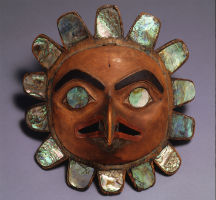
NEWARK, N.J. – This fall, the Newark Museum will unveil its newly redesigned Native American galleries. Featuring more than 200 objects from throughout the United States and Canada, “Native Artists of North America” will present a fully reinterpreted selection of works from the museum’s permanent collection, dating from the early 19th century to the present, including many objects never before exhibited. This long-term installation opens to the public on Oct. 22.
The Newark Museum began collecting Native North American Art in 1910, and that collection has grown to more than 2,000 works of indigenous art from the continental Unites States, Alaska, Hawaii and Canada. While the arts of the Americas includes more than 4,000 objects, ranging from Alaska to Argentina and spanning the pre-Columbian era to the present, “Native Artists of North America” will focus on highlights from Newark’s comprehensive North American collection. By situating the new galleries at the entrance to the permanent installation of American Art, which will be renamed “Seeing America,” the museum reinforces the curatorial philosophy that Native American art is a crucial part of American art.
“This exhibition is about widening the story of American history to include underrepresented artistic and cultural voices, and introducing audiences to American Art that better reflects them and the world around them,” said Steven Kern, the museum’s director and CEO. “This newly expanded introduction to Seeing America will set the tone for the inclusion of multiple voices as visitors continue through the galleries.”
Twenty-seven tribal nations are represented in “Native Artists of North America,” grouped roughly by region to represent the richness of distinct geographic areas and the diversity of living tribal cultures. The result of a collaborative curatorial process involving a number of internationally recognized Native American artists and scholars, the objects on view are organized to highlight strengths of the collection, including Northwest Coast (Haida, Tlingit and Tsimshian), Northern California (Pomo) and the Southwest (Pueblo watercolors and pottery, and Navajo and Hopi textiles).
Additional works by contemporary Native artists will be installed both within Native Artists of North America and in nearby galleries of modern and contemporary American Art and Decorative Arts.
The opening of “Native Artists of North America” represents the first phase of “Seeing America,” an ongoing reinstallation of the American Art galleries highlighting the diversity of the of the American experience through Newark’s rich collections. “Seeing America” will feature new permanent installations of Latin American, African-American and Native American art from the 19th through the 21st centuries integrated throughout the chronological narrative of American art that the galleries present.
For additional information, follow the museum by visiting www.newarkmuseum.org.


